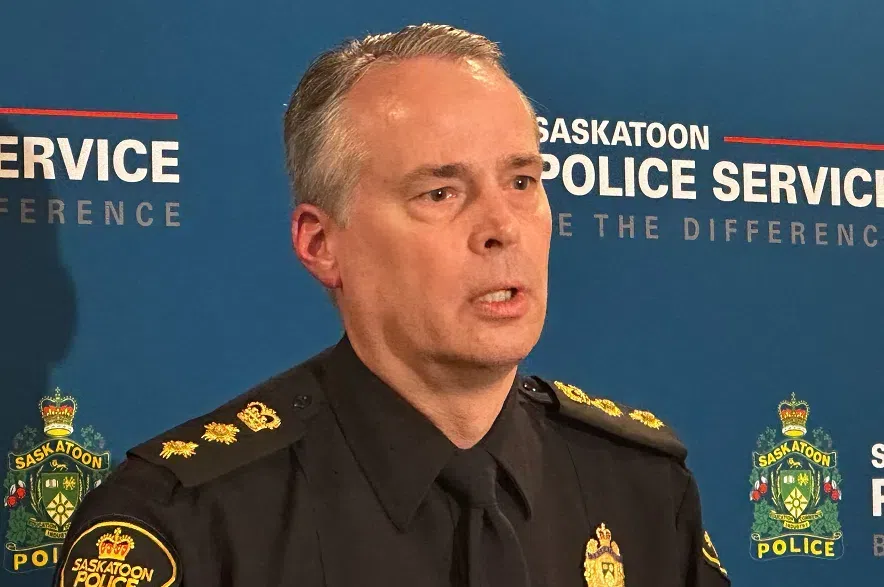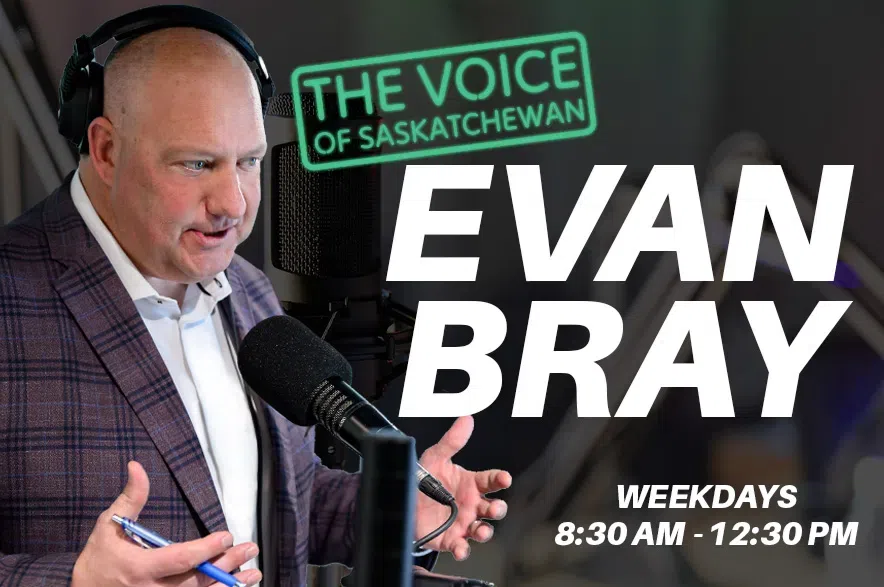Cam McBride, Saskatoon’s police chief, joined the Evan Bray Show on Tuesday for a wide-ranging interview.
The interview covered several recent criminal incidents that have caused concern in the city, the police force’s role in investigating a crane collapse, and the new bylaw aiming to help control bear spray in the Bridge City. McBride also touched on the prevalence of imitation guns and how police are working to make residents feel safe in their city.
Listen to the full interview, or read the transcript below:
The following questions and answers have been edited for length and clarity.
EVAN BRAY: One of the things I think that’s caught a lot of people’s attention is this recent crane accident, a tragic case that happened in Saskatoon. Clearly the Saskatoon police service are called out. Can you talk a bit about that call, and what you’ve learned in the investigation?
CAM MCBRIDE: Basically, what we know is it was a failure of the crane structure. (I) don’t know a whole lot about cranes or the ins and outs, but what the Saskatoon Police Service does – and really any municipal police agency in this type of a circumstance – we guard the scene. We maintain the integrity of the scene. We work really hard at life saving measures upon arrival (and) assist and in any way we can. But the biggest thing is that we don’t actually, at the end of the day, do kind of the nuts and bolts of the investigation. Those things are done through – in a case of an industrial accident or workplace accident – it’s occupational health and safety that does those investigations in co-operation or in concert with the coroner.
If there is deemed, at the end of the investigation, charges to be laid, will the Saskatoon Police Service be brought back into it, or is that still handled outside under the umbrella of the Ministry of Labor?
MCBRIDE: Those types of things are handled outside of the purview of the Saskatoon Police Service, unless there would be some kind of a criminal element involved. And certainly at this point there’s nothing leading us to believe that there’s anything more than just a horrible accident that’s occurred there.
There was a release just yesterday about a teen girl stabbed in the Fairhaven district of the city, and then there was the case of a 14 year old who assaulted a 64-year-old man that happened very recently as well. Can you talk about these cases, chief? Are these random cases? Are these random incidents that are happening?
MCBRIDE: These particular incidents that you’re referring to definitely seem to be random in nature. A lot of the things that we deal with are not random – they’re people who are known to one another or who are immersed in the same circles or the same lifestyles, but in these cases in particular, it definitely seems to be random. And one thing that’s glaring to me recently is the fact that incidents like this happen all over the city of Saskatoon. You know, we had an incident in Fairhaven. We had an incident downtown. We had another incident that was very shocking to the community in Evergreen where, you know, we had an incident at a business, where a firearm was shown…
Is that the gas station altercation?
MCBRIDE: Yeah.
Yeah, OK, I read about that.
MCBRIDE: And so, you know, we have incidents happening all over Saskatoon. The ones that are random are often particularly concerning to community members, because they’re random. You can do the things that you can do to keep yourself safe, to have a good circle of friends and a good lifestyle, but when these random things occur it really rocks people’s world. And the random things are really, really hard to proactively prevent. Where we see crime as a result of drug use or drug culture, where we see organized crime, you know, those things we can investigate, infiltrate, suppress, but when it’s random, it just it’s so hard to deal with those circumstances.
I’m going to ask you a question that I used to not enjoy getting asked as a chief, because you don’t want to ever justify crime that happens when the two people are known to one another, when you were investigating, for example, an assault that happens during a drug ripoff. You’ve got people that are involved in the drug trade. It allows everyday citizens that are not normally stepping into that world to say, “Well, as long as I continue to go about my life and don’t get involved in that, then I’m safe.” When you hear about these random things happen, it calls into question safety in the city. Is Saskatoon a safe city?
MCBRIDE: Does Chief McBride feel safe in the city of Saskatoon? Absolutely I do. And I love to walk in the River Landing area with a cup of coffee in my hand and enjoy everything that downtown Saskatoon has to offer. That is not the experience of other people within the city of Saskatoon, so we all we need to talk about “Do you feel safe?” “Do you feel free to walk about in the way that you want to, wherever you want to?” And many people are saying, “No, I don’t feel safe,” and so we have to respect the feelings and opinions and experiences of every person, and use those experiences and what the community is telling us to really focus our efforts and do our best to make Saskatoon a safe place for everybody, where they’re not only safe but they feel safe.
So how do you do that, chief? We can go through your crime stats and talk about what you’re doing to address car thefts and all of these individual crimes, but when it comes to the perception of safety, how do you tackle that?
MCBRIDE: Perception can be addressed through many things. One of the biggest things is simply showing up, being there, listening. When the community asks for something, being responsive to that, being present, being seen. These are all things that are so very important. And so when we talk about the presence of our (Alternative Response Officers) during weekdays, they have to be outside their cars, they have to be walking, they have to be talking to our community members, our business people downtown. That’s so important. And so when we’re present, when we’re approachable, when we present ourselves as a service that genuinely cares, then the community says “Yeah, OK, we’re in this together. We feel supported.” And we have to be balancing the care for individuals in crisis with holding people accountable, and that balance has to be there. And that’s what I’m saying within our service, is we need to, where we’re out of balance, we need to restore balance. And we need to make sure we’re bringing accountability, and if that comes through enforcement, then that’s what it takes.
You mentioned that altercation in Evergreen a gas station. It happened, I think, over the weekend. Someone presented a gun. My understanding is you made some arrests. You were able to recover the gun. It was a replica, is that correct?
MCBRIDE: Yep, that’s right. And we see, we see so many of them in our community.
I remember dealing with this as well. You can’t say “Because it’s not a real gun, it doesn’t pose a threat.” It poses a threat. Number one, the trauma that it causes people who are at the receiving end of whether it’s a threat, whether it’s a gunpoint, whatever, they don’t know that it’s not real, and even after being told that it’s not it has lingering traumatic effects to them. But also it can cause violence if someone presents a gun, whether it’s on the streets or to police. So how do you tackle that one, chief?
MCBRIDE: It’s extremely difficult. I just was flooded with memories of my childhood where, you know, the cap guns that we would carry had an orange thing on the end or the muzzle part of the gun. You had this red coil of caps sticking out the top of it, and it was crudely made out of plastic. It was very obvious, whereas today, the manufacturers of BB guns and pellet guns are working really, really hard to make them look as realistic as possible. And it doesn’t matter if it’s day or night when we’re interacting with individuals who are presenting these firearms, whether they’re real or not, they look like the real deal and we’re going to treat the individual who put who’s carrying it as if it’s the real thing. We have to.
I want to talk a bit about bear spray. There was recently a new bylaw brought forward for the City of Saskatoon. I know you were part of helping draft that. Can you talk about what that is and what you hope it achieves?
MCBRIDE: So when we were looking at the scope of the issue in Saskatoon, we wanted to make sure that we had adequate legislation and that we were enforcing it to the fullest extent that we could. And so the adequate legislation is coming in the form of that bylaw. So we’ve got age restrictions at the point of sale. We’ve got identification requirements. We’ve got better tracking, so every single can of bear spray sold in the city of Saskatoon has to be marked with a serial number so that we can track it. And those are the things that are coming out in that bylaw that are really going to help us, from a legislative perspective. And then we need to make sure that as police we’re doing appropriate enforcement, we’re laying charges. And not only that, we’ve actually implemented a very dedicated process of following, tracking individuals who are using bear spray in the community, so that when they’re released from court and they have conditions placed upon them, we’re all over it. We’re following up on those conditions and we’re keeping track of those individuals. And so it’s a well-rounded approach. We are definitely seeing, recently anyways, a reduction in bear spray use in the community, and we’re just going to keep at it and we’re going to be diligent to eliminate it from our streets as much as we can.
So the new bylaw you talked about is not in force yet?
MCBRIDE: Correct.
So at this point, if there has been a decline in the amount of bear spray, you can’t attribute it to that, but perhaps some of these other efforts on people who have a history of using it may have curbed some of the problem?
MCBRIDE: Absolutely. And we’ve also been doing some specific project work in the community, some proactive work. We just finished a project that ran here towards the end of June, and within that project we took five firearms off the street. We took 13 cans of bear spray, bats, batons, various other knives and weapons. And so we’re proactively in the community, not as much as I wish – I wish we had lots of opportunity to do proactive policing – but we’re doing what we can with the resources we have right now, and and we’re making some really good headway.
So the the bear spray bylaw, which I think has got lots of of good steps forward in it, addresses retail sales in the city, for example. Do you have a sense of where people are getting their hands on bear spray? Because obviously people can buy it online as well.
MCBRIDE: Yeah, you can buy it online, for sure, but people who maybe don’t have a credit card or who don’t have you know the means to travel great distances to purchase it, unfortunately, they have opportunity to buy it at their local corner stores, which is something that we really do not like, we do not appreciate, but there’s no legislative prohibition for a store to be licensed to sell it. And so we see it in the corner stores. We see it being sold in some of our more vulnerable neighborhoods, and we just have to be on those suppliers, making sure that we’re holding them accountable and even charging them where necessary if they’re not following the bylaw as it comes into force.
What are what are your pressure points heading into the summer, chief? And how do you go about addressing some of the challenges, some of the pressures the city is feeling?
MCBRIDE: Pressure points in the summer are, you know, a lot of opportunity for people just to be out and about at all hours of the night. We see increases in theft, crimes of opportunity, and so being being present, being proactive, doing some of the projects that I’ve already spoken about, just making sure that we’re addressing hot spots or problem areas as those problems occur. And that’s our strategy for the summer. And we rely heavily on the community. When I think about some of the incidents we’ve talked about, it’s really partnership with the community and their involvement that have helped us solve those things. So definitely encouraging the community. Please partner with us. Be a witness. If you see something, say something.
Before I let you go, you’ve got a big community barbecue happening tomorrow. Am I correct?
MCBRIDE: We sure do, on the east side of the police station. We block off the street. We have a community appreciation barbecue. It runs from 11 a.m. until 2 p.m., and we would love to show appreciation to as many residents of the community of Saskatoon as we possibly can. It’s awesome. We have a dunk dunk tank. We have a barbecue. We have live music.
Will we see chief McBride flipping burgers or sitting in the dunk tank?
MCBRIDE: You know what? I’ve been commissioned to provide tours of our building.
Oh, you got you got the easy job, chief, is what happened there. Listen, we appreciate you giving us some time, as always. Thanks so much for for the chat today.
MCBRIDE: You bet.











